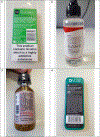Exposure to and perceptions of health warning labels on nicotine vaping products: findings from the 2016 International Tobacco Control Four Country Smoking and Vaping Survey
- PMID: 30618081
- PMCID: PMC6612478
- DOI: 10.1111/add.14550
Exposure to and perceptions of health warning labels on nicotine vaping products: findings from the 2016 International Tobacco Control Four Country Smoking and Vaping Survey
Abstract
Background and aims: The presence and content of health warning labels (HWLs) on nicotine vaping products (NVPs), such as electronic cigarettes, varies by country and manufacturer. We compared proportions of people who report (i) noticing HWLs on NVPs and (ii) feeling concerned having noticed HWLs, by country and by smoking or vaping status. We also examined recall of HWL content and whether this varies by country.
Design: Cross-sectional survey.
Setting: Australia (AU), Canada (CA), England (EN) and the United States (US). At the time of data collection, HWLs on NVPs were only mandatory in EN.
Participants: A total of 11 561 respondents from the following samples in the 2016 International Tobacco Control Four Country Project: (1) re-contacted smokers and quitters who had participated in the previous wave of the project; (2) newly recruited current smokers and recent quitters; and (3) newly recruited current vapers from CA, EN and US.
Measurements: Outcomes included: (1) having noticed HWLs on NVPs, (2) feeling concerned having noticed HWLs, and (3) recall of HWL message content.
Findings: Compared with respondents in EN, respondents in CA were more likely to report having noticed HWLs [odds ratio (OR) = 1.58, P = 0.02], whereas respondents in AU (OR = 0.76, P = 1.00) and the US (OR = 1.54, P = 0.09) were not significantly more or less likely to report having noticed HWLs. Compared with concurrent smokers and vapers, daily smokers, non-daily smokers and quitters were less likely to report having noticed HWLs (ORs = 0.21, 0.33 and 0.19, respectively, all P < 0.001). There were no significant differences in reports of noticing HWLs when comparing concurrent smokers and vapers with daily (OR = 1.62, P = 0.91) or non-daily (OR = 1.15, P = 1.00) vapers. There were no significant differences by country in reporting that HWLs made them concerned about using NVPs. Daily vapers were less likely to report feeling concerned than concurrent users (OR = 0.11, P = 0.017). Among those who reported reading HWLs (n = 688), there was little evidence of differences in recall of the HWL content.
Conclusions: Respondents in England, where health warning labels on nicotine vaping products are mandatory, were not significantly more likely to report having noticed such warnings than those in Australia, Canada and the United States where warnings are not mandatory.
Keywords: Consumer information; electronic cigarettes; health warnings; nicotine vaping products; tobacco health information; tobacco product labelling.
© 2019 Society for the Study of Addiction.
Figures
Similar articles
-
Associations Between Noticing Nicotine Vaping Product Health Warning Labels, Harm Perceptions, and Use Among Adult Vapers, Current and Former Smokers. Findings From the 2018 ITC Four Country Smoking and Vaping Survey.Nicotine Tob Res. 2022 Jun 15;24(7):1020-1027. doi: 10.1093/ntr/ntab256. Nicotine Tob Res. 2022. PMID: 34893915 Free PMC article.
-
Characteristics of nicotine vaping products used by participants in the 2016 ITC Four Country Smoking and Vaping Survey.Addiction. 2019 Oct;114 Suppl 1(Suppl 1):15-23. doi: 10.1111/add.14571. Epub 2019 Apr 30. Addiction. 2019. PMID: 30701622 Free PMC article.
-
Indicators of cigarette smoking dependence and relapse in former smokers who vape compared with those who do not: findings from the 2016 International Tobacco Control Four Country Smoking and Vaping Survey.Addiction. 2019 Oct;114 Suppl 1(Suppl 1):49-60. doi: 10.1111/add.14722. Epub 2019 Aug 15. Addiction. 2019. PMID: 31225672 Free PMC article.
-
Impact of health warning labels on selection and consumption of food and alcohol products: systematic review with meta-analysis.Health Psychol Rev. 2021 Sep;15(3):430-453. doi: 10.1080/17437199.2020.1780147. Epub 2020 Jul 2. Health Psychol Rev. 2021. PMID: 32515697 Free PMC article.
-
Vaping-Associated Pneumothorax: A Systematic Review of Case Reports and Case Series.Medicina (Kaunas). 2025 Mar 19;61(3):537. doi: 10.3390/medicina61030537. Medicina (Kaunas). 2025. PMID: 40142348 Free PMC article.
Cited by
-
Country Participation in the WHO Framework Convention on Tobacco Control Health Warnings Database.Tob Use Insights. 2021 Dec 3;14:1179173X211064214. doi: 10.1177/1179173X211064214. eCollection 2021. Tob Use Insights. 2021. PMID: 34880697 Free PMC article.
-
Predicting the future of smoking in a rapidly evolving nicotine market-place.Addiction. 2019 Oct;114 Suppl 1(Suppl 1):3-5. doi: 10.1111/add.14785. Epub 2019 Oct 7. Addiction. 2019. PMID: 31430832 Free PMC article. No abstract available.
-
An update on controversies in e-cigarettes.Paediatr Respir Rev. 2020 Nov;36:75-86. doi: 10.1016/j.prrv.2020.09.003. Epub 2020 Sep 26. Paediatr Respir Rev. 2020. PMID: 33071065 Free PMC article. Review.
-
Did E-Cigarette Users Notice the New European Union's E-Cigarette Legislation? Findings from the 2015-2017 International Tobacco Control (ITC) Netherlands Survey.Int J Environ Res Public Health. 2019 Aug 14;16(16):2917. doi: 10.3390/ijerph16162917. Int J Environ Res Public Health. 2019. PMID: 31416256 Free PMC article.
-
Evaluating the Influence of Warning Labels on E-cigarette Products and Their Efficacy in Shaping User Perceptions Toward Smoking Cessation.Int J Prev Med. 2025 May 28;16:29. doi: 10.4103/ijpvm.ijpvm_57_24. eCollection 2025. Int J Prev Med. 2025. PMID: 40520029 Free PMC article.
References
-
- West R, Beard E, Brown J. Trends in electronic cigarette use in England 2017. [Available from: http://www.smokinginengland.info/downloadfile/?type=latest-stats&src=11.
-
- McMillen RC, Gottlieb MA, Shaefer RMW, Winickoff JP, Klein JD. Trends in electronic cigarette use among US adults: use is increasing in both smokers and nonsmokers. Nicotine & Tobacco Research. 2014;17(10):1195–202. - PubMed
-
- Reid JL, Rynard VL, Czoli CD, Hammond D. Who is using e-cigarettes in Canada? Nationally representative data on the prevalence of e-cigarette use among Canadians. Preventive Medicine. 2015;81(Supplement C):180–3. - PubMed
Publication types
MeSH terms
Grants and funding
LinkOut - more resources
Full Text Sources
Medical
Research Materials


